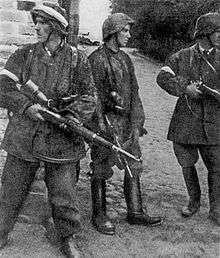Operation Arsenal
The Operation Arsenal, code name: "Meksyk II" (Polish: Akcja pod Arsenałem) was the first major operation by the Szare Szeregi (Gray Ranks) Polish Underground formation during the Nazi occupation of Poland.[1] It took place on March 26, 1943 in Warsaw. Its name was coined after the Warsaw Arsenal, in front of which the action took place. The plan was to free the troop leader Jan Bytnar "Rudy", who was arrested together with his father by the Gestapo. The operation was executed by 28 scouts led by Warsaw Standard Commander Stanisław Broniewski "Orsza". The initiator and the commander of the "Attack Group" was Tadeusz Zawadzki "Zośka".[2]
| Operation Arsenal | |||||||
|---|---|---|---|---|---|---|---|
| Part of World War II | |||||||
 Długa Street where the Operation Arsenal took place | |||||||
| |||||||
| Belligerents | |||||||
|
|
| ||||||
| Commanders and leaders | |||||||
|
| Unknown, probably none | ||||||
| Strength | |||||||
| 28 men | ~15-20 men | ||||||
| Casualties and losses | |||||||
|
2 dead 1 captured (subsequently executed) 140 Polish and Jewish hostages killed in reprisal |
4 killed 9 wounded | ||||||
| Part of a series on the |
Underground State |
|---|
 |
|
Authorities
|
|
Political organizations Major parties Minor parties
Opposition
|
|
Military organizations Home Army (AK) Mostly integrated with Armed Resistance and Home Army Partially integrated with Armed Resistance and Home Army
Non-integrated but recognizing authority of Armed Resistance and Home Army Opposition |
|
Related topics |
The successfully conducted operation led to the release of Jan Bytnar and 24 other prisoners, including another Storm Group troop leader, Henryk Ostrowski "Henryk", and 6 women, in an attack on the prison van that was taking the inmates from Pawiak Prison to Gestapo Headquarters at Szucha Avenue. Bytnar himself died four days later on account of injuries sustained due to German torture. Both of his interrogators, identified as Hubert Schulz and Ewald Lange, were assassinated by Szare Szeregi within two months.[3]
The Operation was presented in a 1978 Polish film Akcja pod Arsenałem[4] and in a 2014 Polish film Stones for the Rampart based on Aleksander Kamiński's novel of the same name.[5]
Details
| Sections | Commander | Members | |||||||||||
|---|---|---|---|---|---|---|---|---|---|---|---|---|---|
| Commander of the operation: Commander of the "Attack Group": Commander of the "Cover Group": |
"Orsza" Stanisław Broniewski "Zośka" Tadeusz Zawadzki "Giewont" Władysław Cieplak |
||||||||||||
| Attack Group | |||||||||||||
| "Bottles" | "Anoda" Jan Rodowicz | "Bolec" Tadeusz Chojko "Heniek" Henryk Kupis "Stasiek" Stanisław Pomykalski | |||||||||||
| "STEN I" | "Maciek" Sławomir Maciej Bittner | "Kołczan" Eugeniusz Koecher "Sem" Wiesław Krajewski | |||||||||||
| "STEN II" | "Słoń" Jerzy Gawin | "Buzdygan" Tadeusz Krzyżewicz (died, due to wounds) "Cielak" Tadeusz Szajnoch | |||||||||||
| "Grenades" | "Alek" Maciej Aleksy Dawidowski (died, due to wounds) | "Hubert" Hubert Lenk "Mirski" Jerzy Zapadko | |||||||||||
| Cover Group | |||||||||||||
| "Signalisation" | "Kuba" Konrad Okolski | "Kadłubek" Witold Bartnicki "Jur" Andrzej Wolski | |||||||||||
| "Old Town" | "Katoda" Józef Saski | "Kopeć" Stanisław Jastrzębski "Rawicz" Żelisław Olech | |||||||||||
| "Ghetto" | "Tytus" Tytus Trzciński | "Felek" Feliks Pendelski "Ziutek" Józef Pleszczyński "Pająk" Jerzy Tabor | |||||||||||
| "Cars" | "Jeremi" Jerzy Zborowski "Jurek TK" Jerzy Pepłowski | ||||||||||||
References
- "Najbardziej spektakularna operacja Szarych Szeregów w czasie okupacji. Rocznica Akcji pod Arsenałem". Retrieved 20 April 2020.
- "Akcja pod arsenałem". Retrieved 20 April 2020.
- "Akcja pod Arsenałem: odbić "Rudego" z rąk Gestapo". Retrieved 20 April 2020.
- "Akcja pod Arsenałem". Retrieved 20 April 2020.
- "Kamienie na szaniec". Retrieved 20 April 2020.
Further reading
- Tomasz Strzembosz: Odbijanie więźniów w Warszawie 1939-1944. Warszawa: Państwowe Wydawnictwo Naukowe, 1972, s. 114